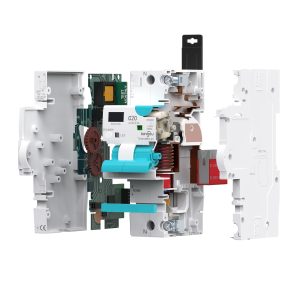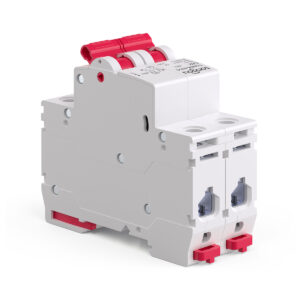
RCBO Trips at Night? Causes, Diagnosis, and Lasting Fixes
RCBO Trips at Night? Causes, Diagnosis, and Lasting Fixes Already know what an RCBO is? Great. This page skips the basics and focuses on nocturnal

This guide to the electrical components behind EV charging is presented by the technical team at TONGOU. As a global leader in circuit protection and control devices, we are committed to ensuring the safety and reliability of next-generation technologies. The installation of an EV charging station must be performed by a licensed electrician.
Bringing home a new electric vehicle (EV) is an exciting step into the future of transportation. To enjoy the full benefit of clean, convenient power, installing a Level 2 home charging station is essential. But behind the sleek interface of the charger itself lies a critical electrical foundation responsible for delivering power safely and efficiently.
This guide will demystify the essential components—like circuit breakers and relays—that form the backbone of a reliable home EV charging system. Understanding their roles will help you appreciate the importance of a professional installation and high-quality parts.
You can’t simply plug a powerful Level 2 charger into a standard wall outlet. It requires its own dedicated circuit running directly from your main electrical panel. Here’s why:
High Power Demand: A Level 2 charger can draw anywhere from 30 to 80 amps of current, far more than a typical 15-amp household circuit can handle.
Continuous Load: Unlike a microwave that runs for a few minutes, an EV can charge for 6-10 hours straight. This “continuous load” generates significant heat and stress on the electrical components. A dedicated circuit ensures no other appliances are sharing this load, preventing overloads.
Safety and Reliability: A dedicated circuit, protected by its own properly sized breaker, isolates the charger from the rest of your home’s electrical system, ensuring safe and uninterrupted charging.
The circuit breaker is the single most important safety device for your EV charger. However, the exact method for sizing it varies slightly by region.
In the US and Canada, the National Electrical Code (NEC) requires using the “125% Rule” for continuous loads.
A 32-Amp charger requires a 40-Amp breaker (32A x 1.25 = 40A).
A 40-Amp charger requires a 50-Amp breaker (40A x 1.25 = 50A).
In regions following IEC standards, the principle is more direct: the breaker’s rating (In) must be greater than or equal to the load current (Ib).
A 32-Amp charger (drawing 32A) requires the next standard size up, which is typically a 40-Amp MCB.
A 16-Amp charger (common for single-phase installations) would require a 20-Amp MCB.
Regardless of location, protecting against electric shock is paramount…
However, EV chargers present a unique challenge. Their internal electronics can produce a type of fault current (smooth DC leakage) that standard household RCDs cannot detect, potentially creating a major safety risk. Therefore, for the highest level of safety, a special type of RCD is required.
For a deep dive into the technical reasons why a specific Type B RCD is essential for EV charging, we recommend reading our expert guide: [Type B RCD for EV Charging Systems and UPS]
In more advanced systems, another component works in tandem with the breaker: a relay or contactor. While the breaker is a safety device, a contactor is an electrically-operated switch.
So, why would you need one?
Smart Home Integration: A small smart relay can’t handle the 40 amps an EV charger draws. But it can handle the tiny amount of power needed to activate a robust TONGOU contactor. This allows you to integrate your EV charging into a smart home system, turning it on or off remotely.
Load Management: In homes with limited electrical capacity, an “Energy Management System” can use a contactor to automatically pause EV charging when another large appliance (like an electric stove) turns on, preventing an overload.
Scheduled Charging: A contactor controlled by a simple timer can provide a hardware-based way to ensure you only charge during off-peak hours when electricity is cheapest.
In these setups, the TONGOU contactor acts as the heavy-duty muscle, safely switching the high power, while a smaller, “smarter” device provides the brains.

The transition to electric vehicles depends on a safe, reliable, and robust charging infrastructure, starting right in your own home. At TONGOU, we provide the critical components that electrical professionals trust for these demanding applications.
High-Amperage Circuit Breakers: Our breakers are engineered for the high-stress, continuous loads of EV charging, providing precise and reliable protection.
Advanced RCDs: We offer specialized RCD solutions, including Type B, to ensure the highest level of protection against all types of fault currents.
Durable Contactors and Relays: Built for industrial applications, our contactors can handle hundreds of thousands of switching cycles, making them the perfect choice for smart charging and load management systems.
When you invest in an EV, you’re investing in the future. Ensure the heart of your home charging system is built with components designed for safety and longevity.

Johnson Lim is the General Manager of Changyou Technology and has over 10 years of experience in circuit protection technology and residential electrical safety. He is committed to developing and producing safer and smarter electrical products.

RCBO Trips at Night? Causes, Diagnosis, and Lasting Fixes Already know what an RCBO is? Great. This page skips the basics and focuses on nocturnal

MCB B/C/D Curves in Practice: How Inrush Current Shapes Your Choice This guide assumes you already know what an MCB is. If you need a

SPD Coordination for Solar PV and EV Charging: Where to Place Type 1/2/3 Already know the difference between Type 1/2/3 and AC vs DC SPDs?

MCB vs MCCB: A Practical Guide to Icu/Ics and IEC 60898 vs 60947-2 This guide assumes you already know what a breaker is. If you

tongou was established in 1993 and is the trademark of Changyou Technology. We position ourselves as providers of intelligent product solutions for high and low voltage electrical systems, taking on solving customers’ pressures and challenges as our responsibility and creating value for them. We utilize intelligent products to serve global customers, making life smarter and more convenient to benefit your life.
Paidong Industrial Zone Qiligang,Yueqing City,Zhejiang province,China.
Sales: [email protected]
After-sales: [email protected]
© 2025 Changyou Technology. All Rights Reserved.

